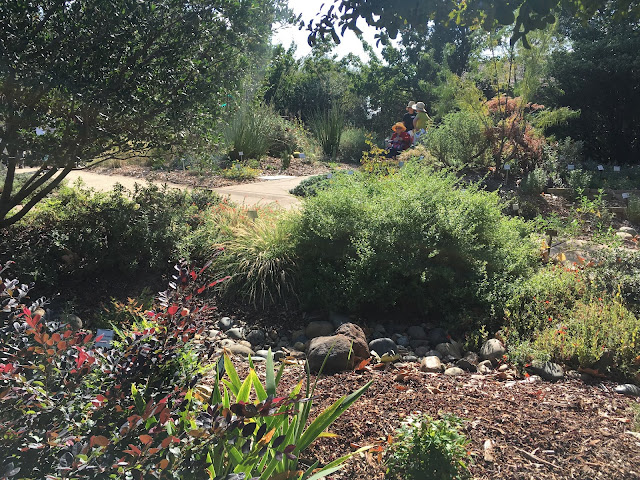
Schools, churches and businesses near American River qualify

|
| Big water-wise gardens, such as the Water Efficient Landscape at the Fair Oaks Horticulture Center, make efficient use of irrigation. Churches, schools and businesses can apply for funding to replace turf and upgrade irrigation systems. (Photo: Kathy Morrison) |
Commercial properties and institutions such as schools or churches often have the biggest lawns. Local water providers want to help get those lawns irrigated more efficiently – or replaced with water-wise alternatives.
With the help of a new rebate program, Sacramento-area schools, churches and businesses can get up to $15,000 for water-wise landscape upgrades. To qualify, the commercial, industrial and institutional properties must be located within 5 miles of the Lower American River.
“Our goal is to make it easy for business and institutional customers to reduce their water use while also improving water quality,” said Amy Talbot, Water Efficiency Program Manager for the Regional Water Authority (RWA), which is administering the program.
Most of our water use in the greater Sacramento region goes toward lawn and landscape irrigation. This rebate program isn’t just about water use; it’s about runoff, too.
About a third of landscape water use is lost due to overwatering and evaporation, Talbot said. “This program is designed to prevent the overwatering and runoff that carries fertilizers and pesticides from landscapes into the storm drain and directly into our rivers, streams and creeks.”
According to the RWA, qualifying properties can receive funding to replace turf with beautiful low-water plants and trees, and to upgrade inefficient irrigation to high-efficiency sprinkler heads, weather-based irrigation controllers, drip irrigation and more. Rebate funding will cover both equipment and professional installation.
The program is available on a first-come, first-served basis until funding is depleted. To learn more, including eligibility guidelines, contact Chris Perry at rwaciiprogram@gmail.com or call 916-967-7653.
The rebate program is funded by a grant from the Bonneville Environmental Foundation.
Comments
0 comments have been posted.Sacramento Digs Gardening to your inbox.
Food in My Back Yard Series
April 29: What's (already) wrong with my tomato plants?
April 22: Should you stock up on fertilizer? (Yes!)
April 15: Grow culinary herbs in containers
April 8: When to plant summer vegetables
April 1: Don't be fooled by these garden myths
March 25: Fertilizer tips: How to 'feed' your vegetables for healthy growth
March 18: Time to give vegetable seedlings some more space
March 11: Ways to win the fight against weeds
March 4: Potatoes from the garden
Feb. 25: Plant a fruit tree now -- for later
Feb. 18: How to squeeze more food into less space
Feb. 11: When to plant? Consider staggering your transplants
Feb. 4: Starting in seed starting
Sites We Like
Garden Checklist for week of April 27
Once the clouds clear, get to work. Spring growth is in high gear.
* Set out tomato, pepper and eggplant transplants.
* From seed, plant beans, beets, cantaloupes, carrots, corn, cucumbers, melons, pumpkins, radishes and squash. Plant onion sets.
* In the flower garden, plant seeds for asters, cosmos, celosia, marigolds, salvia, sunflowers and zinnias. Transplant petunias, zinnias, geraniums and other summer bloomers.
* Plant perennials and dahlia tubers for summer bloom. Late April is about the last chance to plant summer bulbs, such as gladiolus and tuberous begonias.
* Transplant lettuce and cabbage seedlings.
* Weed, weed, weed! Don’t let unwanted plants go to seed.
* April is the last chance to plant citrus trees such as dwarf orange, lemon and kumquat. These trees also look good in landscaping and provide fresh fruit in winter.
* Feed citrus trees with a low dose of balanced fertilizer (such as 10-10-10) during bloom to help set fruit. Keep an eye out for ants.
* Apply slow-release fertilizer to the lawn.
* Thoroughly clean debris from the bottom of outdoor ponds or fountains.
* Start thinning fruit that's formed on apple and stone fruit trees -- you'll get larger fruit at harvest (and avoid limb breakage) if some is thinned now. The UC recommendation is to thin fruit when it is about 3/4 of an inch in diameter. Peaches and nectarines should be thinned to about 6 inches apart; smaller fruit such as plums and pluots can be about 4 inches apart. Apricots can be left at 3 inches apart. Apples and pears should be thinned to one fruit per cluster of flowers, 6 to 8 inches apart.
* Azaleas and camellias looking a little yellow? If leaves are turning yellow between the veins, give them a boost with chelated iron.
* Trim dead flowers but not leaves from spring-flowering bulbs such as daffodils and tulips. Those leaves gather energy to create next year's flowers. Also, give the bulbs a fertilizer boost after bloom.
* Pinch chrysanthemums back to 12 inches for fall flowers. Cut old stems to the ground.
* Mulch around plants to conserve moisture and control weeds.